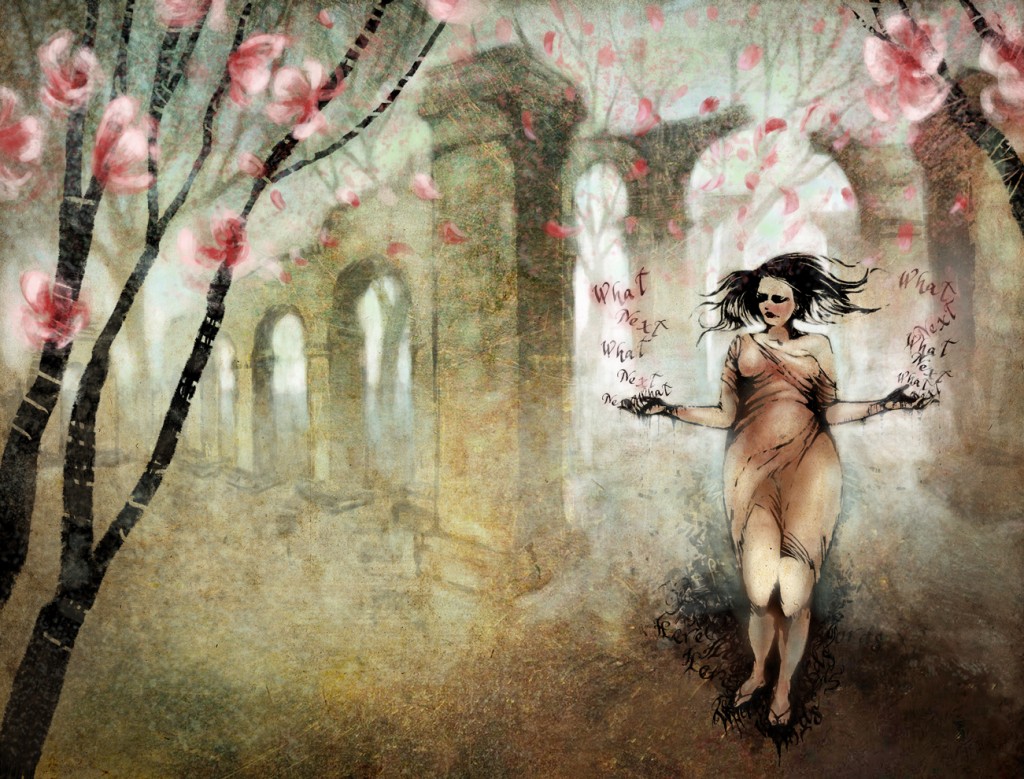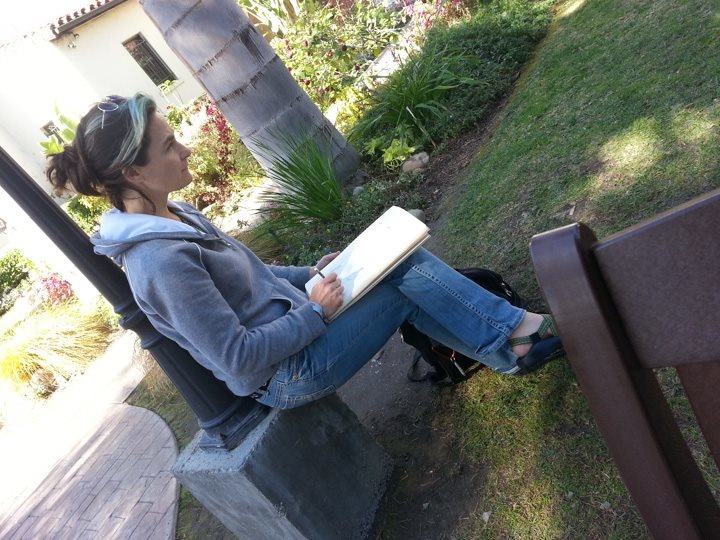The Heart of the Story
by Kat Howard
Illustrated by Galen Dara | Edited by Brian J. White
July 2012
Stories have always fascinated us. The world was created with a word. Or at least so we say, in the story we tell of it. And we believe, because what else could be powerful enough to call a universe into being?
If you look at stories themselves, you might think they come from a muse. She — and oh, it is always she, this beautiful inspiration, this generous giver of words, this faithful servant of the creator — she is invoked with great cries. She is called upon to rage, to sing in the teller, to speak, and so make someone immortal.
She is, I am sure, somewhere even thanked.
Stories, then, come from the muse. There are stories that tell us this, and so it is true. We cannot, after all, imagine a story that lies.
But if there is a muse, as the stories tell us, if she is the source of our stories, then she must get her stories from somewhere as well.
Listen, and I will tell you a story.
The city had grown from stories. Streets were paved with discarded drafts and trees climbed up from heaps of slashed exposition. Certainly there were the type of dwellings more usual in places other than this city, houses made from wood in its original state, before it had been turned into a home for prose rather than for people. But most houses in this city were titles, set on foundations of subheadings and appendices, with the occasional flourish of a prologue added on to dwellings more epic in scope.
There may have, rumor said, been a cathedral once, built of stone and mortar, rather than of couplets and envois hewn to the sky with climaxes and denouements. Residents of the city even worshipped in this stone cathedral, though that was seen as a somewhat vulgar thing to do. Best for the younger, more daring set.
Worship was for things eternal, and stories lasted in a way more mundane structures did not.
Stories, words, were why people came to the city. Where else could one pluck a novelette, ripe and in full flower, from a tree hung also with figs? Or spend the night wrapped in the careful structure of a sestina, more faithful than any flesh and bone lover?
Ink stained the bottoms of Arachne’s shoes as she walked the city streets. When she had first arrived, she would carefully take her shoes off at night, turn them over, and record the words that appeared on their soles, making a commonplace book of her daily travels. She had since fallen out of the habit, but would occasionally sit and read. “Liminal,” “mere,” “antiquated,” her right foot would tell her. “Frolic,” “assemble,” “waltz,” the left. Her left foot always seemed to attract verbs.
Most days, Arachne would wind her path through groves of paragraphs and an arcade of unfinished chapters to the heart of the city. She did not care so much as she used to about trying to compose spontaneous poetry on the soles of her shoes by her choice of path around the city. She cared most for what stood in the city’s heart. Here was the true cathedral.
At the heart of the city, there was a bookstore.
A home for words in a place made of them. See how the conceit falls in on itself, like a book printed accordion-fold. A conceit, yes, but sometimes a conceit is the proper thing for the shape of the story.
Creativity in structure is all well and good. But what I crave is art. Story. The blood that runs between the bones.
Ben Loory’s Books, the place was called. The building looked as if it had been grown from the city’s literate soil, as if fragments of dictionaries, epics, romances, had been watered with ink, then covered over carefully with endpapers, until one day springing forth fully formed into a house of story. Its roof was shingled with quarto pages, and they fluttered as if breathing.
The floor sighed as Arachne stepped across the threshold, and the volumes settled quietly into place. She did not see anyone else in the shop as she walked in.
Arachne passed between lined shelves of books, which framed the interior doorway like an honor guard. She saw no one still, but somewhere, somewhere just on the edge of hearing, was breath or heartbeat. Presence. Arachne saw no one, but knew she was not alone in Loory’s Books, and the presence was comfort.
She stepped into the labyrinth of shelves, and if she had looked at the bottoms of her shoes, the right would have read “thread,” “love,” “monster,” and the left “turn,” “run,” “transform.”
Transform.
Here. I will tell you another truth. A bookstore is a metaphor. It is a time machine, a small box bigger on the inside, the original stage upon which all the world is played. The inside of a bookstore is a costume, a map upon which Ultima Thule and Hic Iacet Draconis are writ in the margins.
In a city made of stories, a bookstore holds the entrails through which the future is divined. It is the lock on the box in which hope is contained.
In a city made upon stories, words are not made flesh, they are made structure. The structures of Loory’s Books are cinquains and sonnets, triolets and villanelles — the frameworks that support the words that run riot and explode inside of the rules.
The rugs on the floor, worn by countless readers’ feet, have — if you look closely between the knots that hold the patterns together — occasional lines of dialogue tucked in amongst tassels of description. There is an art to interweaving the two, and a well-made storyrug is a treasure.
These were not Arachne’s preoccupations as she walked farther into the shelves, running her fingers along embossed titles and leather bindings. And while it is a metaphor that bookstores are bigger on the inside, in this instance it is truth as well. The further in that Arachne walked, the more shelves there were, and the more volumes on those shelves.
It is the nature of stories to find an audience. They want to be told. They crave being heard. They will go where the audience is. And certainly in a city where you might sit on a bench and enjoy the sensation of small fictions falling into your lap, intermingled with feathers from local birds, it is a unique thing, an event all out of time and place, when someone walks into a bookstore looking for the story of her heart.
Still, if you had asked Arachne what she had walked into the store in search of, she would not have been able to articulate it. There had been a need, that much she knew, but the need did not yet have a name.
Desire lies at the heart of all stories. Books are not opened unless the contents of their pages are wanted. Writers want, and readers want, and somewhere in the imperfect mirror of those cravings, story is born, fierce and screaming, as the products of passion often are. It will never look exactly like you expect.
Desire feeds a story, and causes the reader to turn the page, in time with a heart that beats, “what next, what next, what next?”
Just remember as you read, that you are not the first one who has wanted.
Arachne had walked deep into the bookstore, and from the corner of her eye, the shelves looked like hedges of yew or rosemary, like stone walls built to hide the monster at her heart. And yes, as much as every story has a muse, every story has a monster.
Often, the two are the same.
Arachne had brought no breadcrumbs to mark her trail out of the forest, no enchanted thread to unspool and so better flee to safety.
Stories, true stories, are not safe. They are forests, dark and wild, and they send birds to eat the breadcrumbs. They seduce the maiden, and claim her enchanted thread.
The lights of the store had dimmed, or become the slant of sun in the late afternoon, or the moon with clouds scattered across her face, and there were no longer long pine boards and spines of books beneath Arachne’s feet, but pine needles and moss and worlds of leafmould, calligraphied into letters that carpeted the floor of the forest where stories are born.
It had been miles, and her legs ached from walking. The back of her left heel was blistered from her shoe, but she had no desire to turn back, or find a way out. There was a pressure in her center, and behind her eyes. There were words that must be spoken. She walked on. “Words, words, words,” read the sole of her left shoe.
The Arachne stepped past the shelves of books that were also sometimes trees hung with pages, and into a clearing. “Here, here, here,” scrawled in ink across the bottom of her right shoe.
She sat down.
In the heart of every story is a forest, a tangle of words and thoughts, overgrown with secrets. You knew what would happen when you chose to walk into the woods. You were warned. There were dangers.
Do not stray from the path.
Beware of grandmothers’ houses. They will be made of candy, or contain wolves, or have chicken legs. In any event, you will be devoured.
Your eyes will be anointed by the petals of a flower and you will fall into love. Or into foolishness. They may be the same. You may not fall back out.
Once upon a time.
Into the woods.
Every bookstore is, at its heart, a forest. Pages begin their dreaming as trees, and the tangle of story has its roots there as well.
In the heart of the forest that is the heart of the bookstore that is the heart of a city sits a woman, and as she sits, a story writes itself to the beat of her heart.
This is where ideas come from. This is where I get my stories.
The heart that she sits in is mine.
Arachne unfolds herself from the floor of Loory’s Books. She blinks her eyes and the forest turns back into a labyrinthine arrangement of bookshelves. The floorboards, warm gold beneath the storyrugs, sigh beneath her steps as she walks back down the stairs, towards the front of the store. The shelves, in hexameters of dactyls, settle back into place, and the volumes that rest upon them slide back into their homes.
One volume more, cordovan calfskin, still smelling of the dark wildness of the heart of the forest, quivers slightly as it takes up residence in the top right corner of a case fronted with leaded glass. This is the private collection of Loory’s Books. Each volume is exceeding rare, unique in all the world.
Arachne crosses the threshold of the bookstore, steps back onto streets cobbled with five-act arcs, lists of dramatis personae, and epilogues mixed into the mortar. The sole of her right shoe reads “heart,” “forest,” “end.”
The sole of her left shoe is blank.

